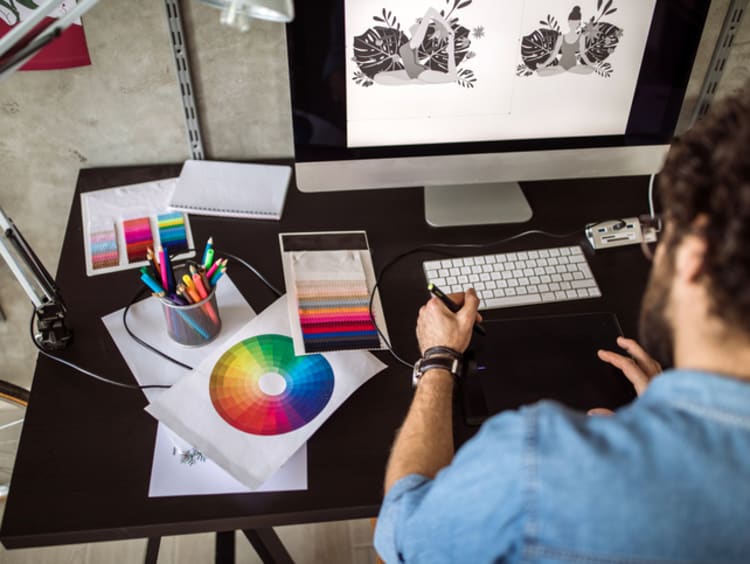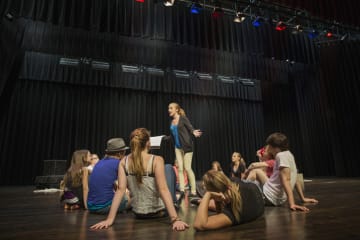Improve Digital Artist Productivity With Generative AI

In the ever-evolving realm of digital art, artists can find themselves at the intersection of tradition and innovation. One of the most transformative forces in this landscape is generative artificial intelligence (AI). Generative AI is a dynamic tool that empowers creators to elevate their productivity and explore uncharted creative territories. This blog delves into the ways digital artists can seamlessly integrate AI into their workflow, unlocking new dimensions of creativity while utilizing generative AI tools and emphasizing the indispensable role of human imagination.
In This Article:
- What Is Generative AI?
- Exploring Design Possibilities With Gen AI
- Generative AI Tools: Enhancing Photo Editing
- AI and Creativity: Creating Collaborative Art
- Streamlining Artistic Workflows: AI as the Ultimate Creative Assistant
- The Future of Generative AI
What Is Generative AI?
First, we must further understand what is generative AI and its impact on the digital world. Digital artists often grapple with a multitude of mundane and time-consuming tasks that detract from their creative pursuits. Generative AI serves as a liberator in this regard, automating tasks such as colorization, background removal and initial sketch generation. By delegating these routine chores to AI algorithms, artists not only regain valuable time, but also find a newfound freedom to delve into the core of their craft — the imaginative and expressive aspects that define their unique artistic voice. This liberation from the mundane allows for a more profound connection between the artist and their creation.
Beyond timesaving, the impact of automating mundane tasks extends into the nuanced details of the artistic process. For instance, AI-driven colorization algorithms can analyze color palettes from historical artworks or nature, providing artists with a rich palette to choose from or offering suggestions based on the emotional tone they want to convey. This level of automation not only streamlines the workflow, it also introduces artists to a broader spectrum of creative possibilities, enriching their artistic vocabulary.
Exploring Design Possibilities With Gen AI
Generative AI tools provide artists with a revolutionary means of exploring diverse design possibilities. AI becomes a co-creator as artists input parameters or constraints and witness AI generating variations of their artwork. This serves as a wellspring of inspiration and encourages artists to explore new avenues of creativity. The collaborative dance between human intuition and AI's computational prowess can create a symphony of ingenuity that propels digital art into uncharted territories.
To elaborate further, the generative capabilities of AI extend beyond static images. Artists can utilize generative AI to explore dynamic design possibilities, generating variations of animations, interactive elements or even virtual reality experiences. AI and creativity work together to create a realm of possibilities for digital artists to build immersive and engaging art forms that go beyond traditional static representations. The synergy between human creativity and AI's ability to process vast datasets in real time can transform the artistic process into a dynamic, ever-evolving dialogue between artist and machine.
Generative AI Tools: Enhancing Photo Editing
AI's impact extends beyond the traditional processes of photo editing for digital artists. Intelligent algorithms can seamlessly enhance images, remove imperfections and transform visuals into various artistic styles. The efficiency brought by AI in complex edits and transformations not only expands the artistic possibilities for creators but also transforms AI into a virtuoso assistant. This may help artists express themselves with unparalleled precision and artistic finesse.
The virtuosity of generative AI in photo editing becomes even more pronounced when considering its ability to understand artistic styles. AI algorithms, trained on a diverse range of artistic genres and historical masterpieces, can analyze an artist's work and suggest editing styles that align with their unique aesthetic. This can save time for the artist and act as a knowledge repository, introducing them to different artistic movements and helping them refine their own style.
AI and Creativity: Creating Collaborative Art

In a groundbreaking paradigm shift, artists now find themselves collaborating with AI as a creative partner. By inputting their artwork or ideas into AI models, artists witness the emergence of unique combinations, styles, or even collaborative pieces. The relationship between human creativity and AI-driven collaboration transcends individual capabilities, opening up avenues for innovation that go beyond what either party could achieve alone.
This fusion represents a bold step into the future of art, where the boundaries between creator and creation blur. The collaborative possibilities with AI extend into realms of storytelling and narrative creation. Generative AI tools can analyze an artist's thematic choices, suggest new narrative directions on character designs and plot structures, and brainstorm alternative story arcs. This collaborative storytelling not only enhances the creative process but also introduces artists to unconventional and thought-provoking narrative approaches, enriching their artistic narratives.
While AI has the capability to generate impressive media independently, its true potential is unleashed when combined with human creativity. Digital artists can use AI algorithms to generate initial ideas, explore compositions, and even create intricate elements in their artwork. AI can become a powerful tool for artists to enhance their creative process, offering a fresh perspective and opening doors to uncharted artistic territories. The harmonious integration of AI into the artistic process can potentially transform it from a mere tool to a catalyst for unparalleled creativity.
Expanding on the idea of AI as a catalyst, consider the role of AI in conceptualizing and ideating artistic projects. By analyzing an artist's body of work and identifying recurring themes, motifs or stylistic choices, AI can suggest new project ideas that align with the artist's unique voice. This proactive role of generative AI in the ideation phase not only sparks creativity but also ensures a continuity in the artist's thematic exploration, contributing to a cohesive and evolving artistic portfolio.
Streamlining Artistic Workflows: AI as the Ultimate Creative Assistant
The integration of AI into artistic workflows represents a paradigm shift in the relationship between artists and their tools. By automating tedious tasks, suggesting improvements, and predicting artistic preferences, AI-powered software becomes an invaluable assistant to the artist. Through the comprehensive analysis of an artist's body of work, AI identifies patterns and offers nuanced suggestions, enabling artists to optimize their creative process and focus on authentic artistic expression. The result is not just an enhancement of efficiency, but a transformation of the creative journey itself.
In the realm of workflow optimization, generative AI tools can be leveraged to create personalized artistic assistants. These AI-driven assistants, tailored to the artist's preferences and working style, can provide real-time feedback, suggest alternative approaches, and even assist in project management. This level of customization ensures that AI seamlessly integrates into the artist's workflow, becoming an intuitive extension of their creative process rather than a separate tool.
The Future of Generative AI
Embracing the potential of AI in digital art represents a revolutionary shift in the creative landscape. It can offer aspiring artists, especially those in undergraduate arts and media programs, an opportunity to leverage AI's power for increased productivity, exploration of new artistic territories, and the attainment of greater outcomes. While AI can generate remarkable pieces of media, it is essential to acknowledge that human creativity remains the heartbeat of artistic creation.
As we dive into the future, envision a digital art ecosystem where AI acts as a collaborator, mentor and muse. AI-driven mentorship programs could analyze an artist's developmental trajectory, providing personalized guidance, constructive critiques and tailored learning resources. This symbiotic relationship between artist and AI mentor not only accelerates skill development but also fosters a sense of continuous growth and artistic evolution.
In conclusion, the future of digital art beckons artists to embrace the symbiotic relationship between human imagination and AI capabilities. By merging tradition with cutting-edge technology, artists can embark on a journey of exploration, pushing the boundaries of what is possible in the realm of digital creativity. The canvas is vast, and the fusion of human ingenuity with AI innovation promises a future where the only limit is the boundless imagination of the artist. The digital art revolution awaits those willing to embark on this exciting journey.
Are you ready to embark on your creative journey at Grand Canyon University, where you can immerse yourself in the synergy of experienced faculty and modern technology? Discover the thrilling opportunities offered within GCU's digital arts degree programs through the College of Arts and Media. Embrace the potential that awaits you in the realm of artistic expression and innovation.
Approved by faculty chair for the College of Arts and Media on Dec. 20, 2023.
The views and opinions expressed in this article are those of the author’s and do not necessarily reflect the official policy or position of Grand Canyon University. Any sources cited were accurate as of the publish date.


